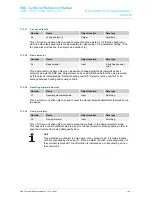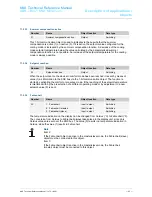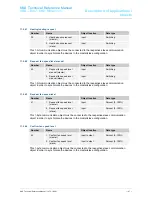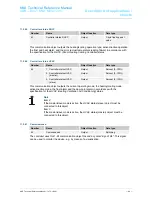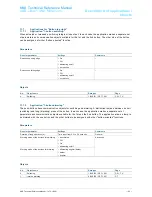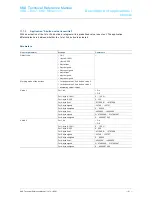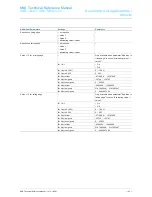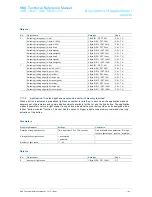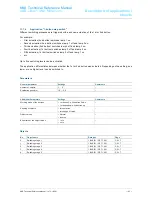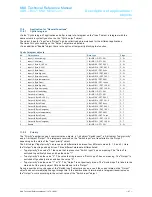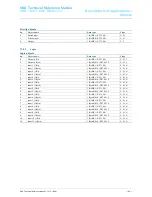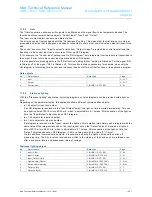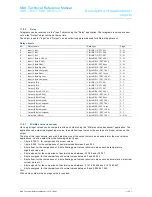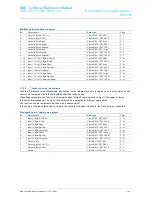
KNX Technical Reference Manual
ABB-i-Bus
®
-KNX Millenium
Description of applications /
objects
KNX Technical Reference Manual | 1473-1-8681
— 97 —
Pos: 31.24 /Layout bis 2014-11-11/Online-Dokumentation (+KNX)/Überschriften (--> Für alle Dokumente <--)/2. Ebene/A - F/Applikationen "Allgemeine Funktionen" @ 41\mod_1422535767390_15.docx @ 331396 @ 2 @ 1
11.8
Application for "General functions"
Pos: 31.25 /Layout bis 2014-11-11/Online-Dokumentation (+KNX)/Überschriften (--> Für alle Dokumente <--)/3. Ebene/S - T/Telegramm zyklisch @ 41\mod_1422540773027_15.docx @ 331535 @ 2 @ 1
11.8.1
Cyclic telegram
Pos: 31.26 /Layout bis 2014-11-11/Online-Hilfe/Power-Tool/Power-Tool 2/chm-Online-Hilfe/App/Zyklisch/App. - Telegramm zyklisch - DIN-A4 @ 10\mod_1269511411745_15.docx @ 53158 @ @ 1
Via the "Cyclic telegram" application and after receipt of a telegram on the "Input" object, a telegram with the
same volume is cyclically sent out on the "Cyclic output" object.
The object types for "Input" and "Output" can be collectively parameterised for the different applications.
The times for cyclic sending on the "Output" object are adjustable.
Via an additional "Enable" object, there is the option of temporarily blocking the function.
Cyclic telegram objects
No.
Object name
Data type
Flags
0
Input (1-bit switching)
1 Bit EIS1 / DPT 1.001
C, W
0
Input (1-bit alarm)
1 Bit EIS1 / DPT 1.001
C, W
0
Input (1 Byte 0..100 %)
1 Byte EIS6 / DPT 5.001
C, W
0
Input (1 Byte 0..255)
1 Byte EIS14 / DPT 5.010
C, W
0
Input (2 Byte Float)
2 Byte EIS5 / DPT 9.xxx
C, W
0
Input (2 Byte Signed)
2 Byte EIS10 / DPT 8.001
C, W
0
Input (2 Byte Unsigned)
2 Byte EIS10 / DPT 7.001
C, W
0
Input (2-byte temperature)
2 Byte EIS5 / DPT 9.001
C, W
0
Input (4 Byte Float)
4 Byte EIS9 / DPT 14.xxx
C, W
0
Input (4 Byte Signed)
4 Byte EIS11 / DPT 13.001
C, W
0
Input (4 Byte Unsigned)
4 Byte EIS11 / DPT 12.001
C, W
1
Output (1-bit switching)
1 Bit EIS1 / DPT 1.001
C, T
1
Output (1-bit alarm)
1 Bit EIS1 / DPT 1.001
C, T
1
Output (1 Byte 0..100 %)
1 Byte EIS6 / DPT 5.001
C, T
1
Output (1 Byte 0..255)
1 Byte EIS14 / DPT 5.010
C, T
1
Output (2 Byte Float)
2 Byte EIS5 / DPT 9.xxx
C, T
1
Output (2 Byte Signed)
2 Byte EIS10 / DPT 8.001
C, T
1
Output (2 Byte Unsigned)
2 Byte EIS10 / DPT 7.001
C, T
1
Output (2-byte temperature)
2 Byte EIS5 / DPT 9.001
C, T
1
Output (4 Byte Float)
4 Byte EIS9 / DPT 14.xxx
C, T
1
Output (4 Byte Signed)
4 Byte EIS11 / DPT 13.001
C, T
1
Output (4 Byte Unsigned)
4 Byte EIS11 / DPT 12.001
C, T
2
Enable
1 Bit EIS1 / DPT 1.001
C, W
Pos: 31.27 /Layout bis 2014-11-11/Online-Dokumentation (+KNX)/Überschriften (--> Für alle Dokumente <--)/3. Ebene/P - R/Priorität @ 41\mod_1422540869951_15.docx @ 331552 @ 2 @ 1
11.8.2
Priority
Pos: 31.28 /Layout bis 2014-11-11/Online-Hilfe/Power-Tool/Power-Tool 2/chm-Online-Hilfe/App/Prioritaet/App. - Priorität - DIN-A4 @ 10\mod_1269513570444_15.docx @ 53219 @ @ 1
The "Priority" application has 3 communication objects, a 1-bit object "Switch input", a 2-bit object "Input priority"
and a 1-bit object "Output". The telegrams received on the "Switch input" are transferred to the "Output"
depending on the state of the "Input priority" object.
The 2-bit object "Input priority" can receive and differentiate between four different values (0, 1, 2 and 3). Here,
the "Output" object is positively driven. Three different states are differentiated:
– "Input priority" has value "3": the value that is present on "Switch input" has no meaning. The "Output" is
switched to positively driven and has the value "1".
– "Input priority" has the value "2". The value that is present on "Switch input" has no meaning. The "Output" is
switched off positively driven and has the value "0".
– "Input priority" has the value "1" or "0". The "Output" is not positively driven. The "Switch input" is linked to the
status bit of the priority object OR and transferred to the "Output".
During a positive drive, changes of the "Switch input" object are saved, even if the current state on the "Output"
object does not immediately change through this. If the positive drive is terminated, a telegram transmission on
the "Output" occurs according to the current value of the "Switch input" object.

